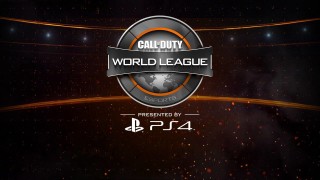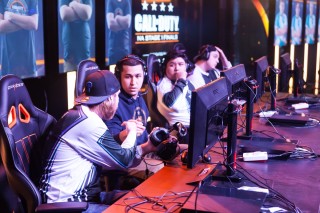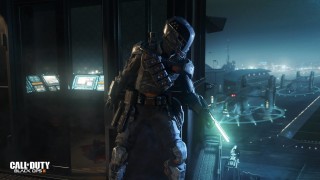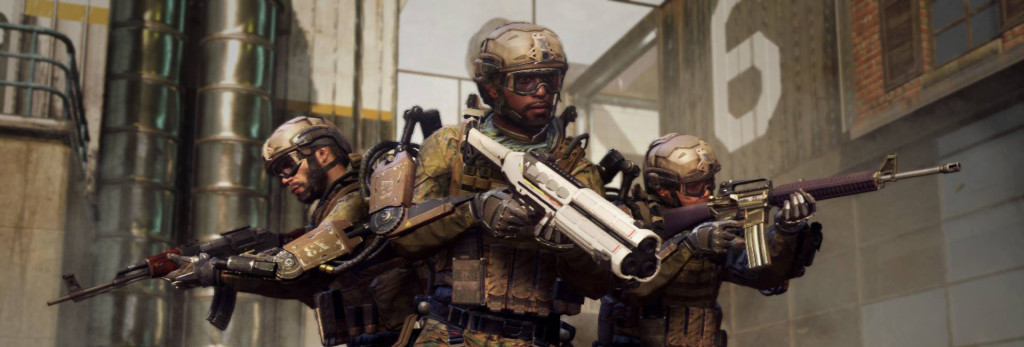The Call of Duty World League Stage 1 finals are about to begin as the best teams in North America battle it out for their share of $250,000.
David Vonderhaar, Treyarch Studios’ designer director, is standing front and center at the ESL studios in Burbank, California, taking in all the action, navigating the intimate space with an infrared scope on determining next-level fixes with the production staff, and players alike.
Although his job since 2005 as designer for six COD installments is to make one of the most popular game franchises of all time consistently better than the previous version, he’s making mental notes on how to make the eSports experience just as great as the gameplay—where the players and caster desks are positioned, and how it affects the overall spectating experience both in person, and at home. Such is the life of a creative who makes more maps than Magellan.

“I get fascinated by the process side, and turning it into one that’s cyclical, focusing on the next important thing we could be concentrating and improving on,” Vonderhaar tells [a]listdaily. “Having that direct feedback from the community is important. All you can really do as a developer, and as a human being, is just try really hard to make things better. … Even if it’s just one more thing you can do.”
Publisher Activision’s sci-fi military shooter Black Ops 3 has been the top-grossing console game since it was released in November—it generated over $550 million in worldwide sales in its first 72 hours. In recent months, they’ve taken dead aim on weekly live broadcasts, regional competitive events, and their largest prize pool yet with more than $3 million on the line.
They also launched Live Event Viewer this month on PlayStation 4 to let players watch COD World League matches from within the game; there’s also community-focused programming, like developer-hosted livestreams, that complements the first year of the league.
Jay Puryear, Treyarch’s director of brand development, says their three COD World League regions—Europe, North America, Australia/New Zealand—each have their own unique style.
“Looking at all of these regions, there’s really a growth potential for all of us from an eSports perspective,” Puryear said. “With the Live Event Viewer, we are noticing viewership growth from across the world. We’re all pushing each other. We see the potential. We see where we want to go. … For us, it’s about growing that engagement and giving eSports a platform through not only live events, but in-game to ultimately help grow the audience.”
The combination of production value and spectator tools, like seeing the silhouette of players through buildings, is delivering the drama, and really opening up viewership to non-traditional eSports players.
Vonderhaar, who’s largely responsible for the development of multiplayer in the COD franchise, joined [a]listdaily to discuss how eSports has impacted the franchise.
What is the best part about attending an eSports event in person? What do you learn?
For us on the development side, there’s a good consortium of people inside our building at Treyarch Studios that really are super in tune with what’s happening when we take the game, and it gets played on this level. It’s a lot of fun for us. It’s a lot of fun to see the game get exposed to lots of people. In general, you get this great swelling—like all the streams are on the TVs back at the office. There’s enthusiasm to see all this hard work over the last three years come to these moments.
What have been your chief takeaways from COD World League?
The business of eSports is a pretty fascinating thing, right? But at the end of the day, we have to work on the game. We have to make the game super competitive. We have to keep that playing field fair and balanced. We have to think about all of the things that go into letting the game become a spectator experience, with features like our COD Caster, which is a spectating view. The live-event viewer that lets you stream inside the game. Even the custom game setup, and how people can set up to play competitively in the first place. So all of our energy from the business side is translated into the development side, because that’s what we do. There’s really impassioned conversations about ‘where this could go, where you need to be, and what that the roadmap looks like.’ From a practical point of view, on a day-to-day basis, you can get caught up and overwhelmed in sort of the fun, business side of things. But you’re making a game. You have to be focused on the game, and that’s what we do on our side of the fence.
There’s so much competition in the market. As a designer, how are you differentiating yourself from the pack to own a large share of the gaming audience?
Call of Duty is a really big, popular franchise with a heavy, passionate install base. Right off the bat, we have a great opportunity to take that audience and bring them into the eSports world, and show them what the eSports side can look like. And as big as the eSports side of it is for Call of Duty, there are still a lot of people who perhaps are not familiar with it. Over the years, we’ve been able to do things to help grow that audience, and build awareness, and exposure to it. But as developers, you’re really focused on just making a great, competitive game, and a great competitive game can be a really great eSport. That’s how we approach that problem. You can focus on how large numbers of people could enjoy a game competitively, and how the game services this broad, potential audience of players but also maintains its competitive nature. There’s a constant tendency, and a very healthy push-and-pull on the development side between things that are fun for everybody, and things that are fun for competitive. And they’re not always the same things, and I think that’s the design challenge. And that’s what makes things fun because design is about solving problems.

How crucial has eSports been to engaging with the Call of Duty audience?
What you get from eSports and engagement is this new opportunity to put new engagement loops inside the game. We’ve been doing different types of engagement loops from a game design point of view for a very long time: How you level up; who you pick to unlock; which types of abilities you select as a player to play as; what type of challenges are available; how we do double XP, double weapon XP, double crypto key. All of these things are engagement-driving loops, but eSports gives you this new thing because there’s this awesome cadence of stuff that happens on a routine basis when you’re doing an eSports season like the COD World League. It gives one more tool in your designer’s tool box. And now, we can say ‘OK, this is the eSports event driver, this is what we’re getting people to pay attention to this week.’ For us, it’s great because you can combine that with 10-plus years of experience working on the game franchise.
How has the development style changed from the first Call of Duty till today for this new generation of gamers?
The new generation of gamers, from one point of view, like a lot tighter gameplay loop. They like the game very, very fast. Over the years, on the development side, we’ve been trying to figure out how to keep the game as fast as you can to engage those players. But also, very fast games can be difficult to spectate. There’s this constant push-and-pull and balance trying to figure out ‘how to make a game that’s fun to watch that’s also fun to play.’ And that’s what you’ve been seeing over the years as the game gets faster, but also maintains the integrity about how to watch that experience. … Things happen in Call of Duty in microseconds, in some ways. Like the COD Caster feature: with eight players in the battle space, and only spectating one, you have to have this information so that the Casters have the spectator predict where the action is going to materialize. It’s been fun to think about that problem.

What are the current challenges you’re trying to overcome? How are you improving gameplay?
As an eSport, there’s a desire to want to contain the available amount of content accessible. From a development challenge point of view, it’s ‘how do you build compelling content that can be usable and competitive,’ but also appeal to the rest of the population? One of the challenges for us has always been ‘what modes are we playing; what are the rules of those modes; what’s allowed to be played in those roles?’ … It’s created this whole new kind of meta that’s uniquely new for the COD World League and Black Ops 3 that didn’t exist.
Has eSports changed the landscape of the Call of Duty community?
It does change, and the players have changed. But I think of it in terms of maturity and growth. Everyone gets a little better every time we do this. There’s certainly a growth in the competitive community, how they’re approaching the game, what they’re playing. It’s impacted us on the development side in terms of what features we’ve prioritized to construct. … We’ve maintained a healthy relationship with direct contact with players. That growth has been challenging, too, because you can only take so many phone calls in a day and still make video games. But I love it.

How often do you get to play?
I actually am having a hard time getting to play. I’m not playing Black Ops 3 for fun, but I play everyday because we’re still developing, and we have DLCs we’re making. I joke that when the game comes out, it’s only halftime. We make as many maps after the game comes out as we made on the release. There is a tremendous amount of stuff going on.
What is your favorite part of the design process?
Every single day we are updating the game. Being able to tell the community about the hot fix or the small patch that doesn’t require download is fun for me. I do it because I want to, and I like that part of it a lot. Having players be in the loop influences the next round of stuff. In a post-ship world, it’s the most fun part.
Follow Manouk Akopyan on Twitter @Manouk_Akopyan.

